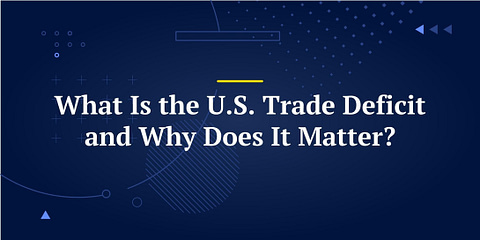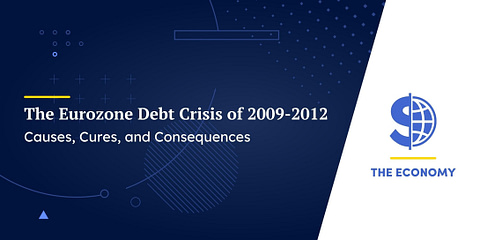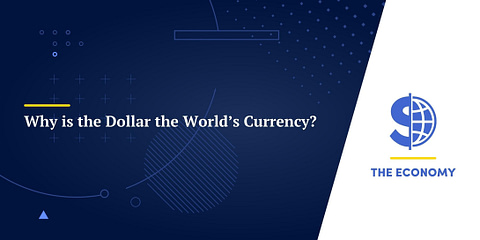If you follow the discussion around cryptocurrency investment, you know the claims: the Fed is printing way too much money, hyperinflation is imminent, the dollar is doomed. The only way to survive is to put your money into scarce assets with limited supply, like cryptocurrencies. It’s dollar vs. crypto, and the dollar is losing. But how well do those claims stand up to critical examination?
Let’s take a look.
Supply and Value
One part of this proposition is certainly true: the number of US dollars in circulation has been increasing dramatically for many years. Let’s look at the figures.
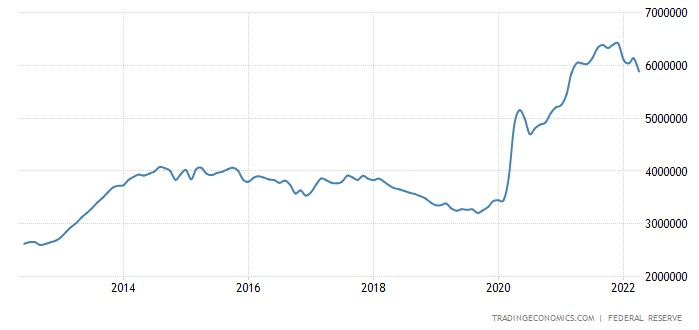
But how has that increase in supply affected the value of the dollar? Let’s look at the US Dollar index, which measures the value of the dollar relative to a basket of currencies.
📈 The index base is the value in March 1973, when the governments of several major nations agreed to let the value of their currencies “float” or be determined by the market. The March 1973 base is 100, so any figure under 100 indicates that the dollar has lost value, any figure over 100 indicates that the dollar has gained value.
Here’s a 1 year dollar index chart.
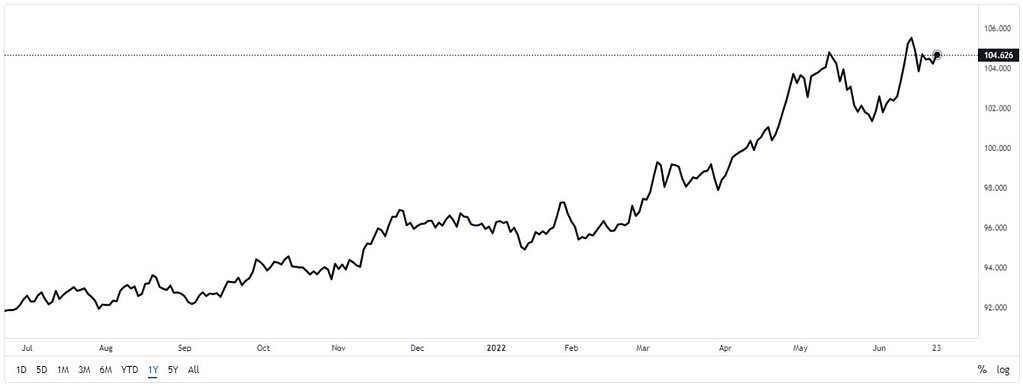
So the dollar is plummeting… it’s true! Well, not so fast. Let’s look at a wider perspective. Here’s a longer-term chart.
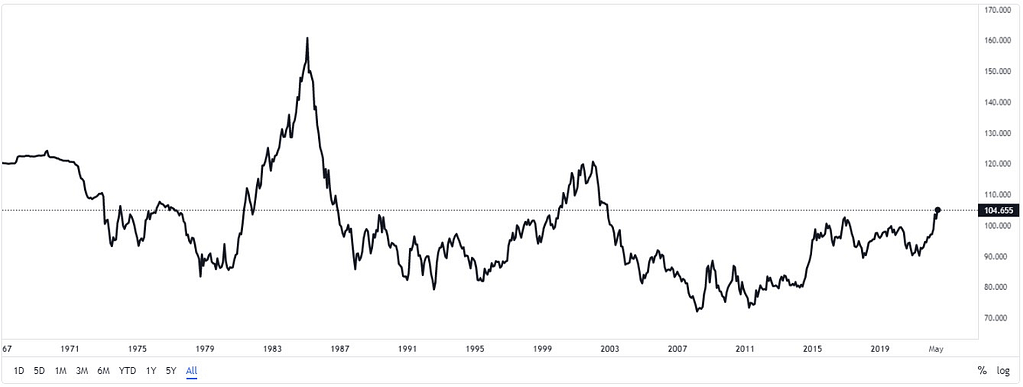
What we see is that while the dollar’s value has fluctuated since 1973, it has only rarely moved more than 20% above or below the base value, and it’s currently just over 7% below its 1973 value relative to other currencies. The increase in dollar supply has not forced the value of the dollar down relative to other currencies.
What Keeps the Dollar Afloat?
So why is this the case? Why isn’t the value of the dollar plummeting as the number of dollars in circulation grows?
There are two reasons. First, the other currencies in the dollar index comparison basket have also seen substantial increases in money supply. Keeping money supply constricted is not always a good thing for a country. It forces the value of a currency up, which makes exports harder to sell and imports cheaper. It also forces interest rates up, which crimps economic growth. Let’s look at the money supply of some other prominent currencies.
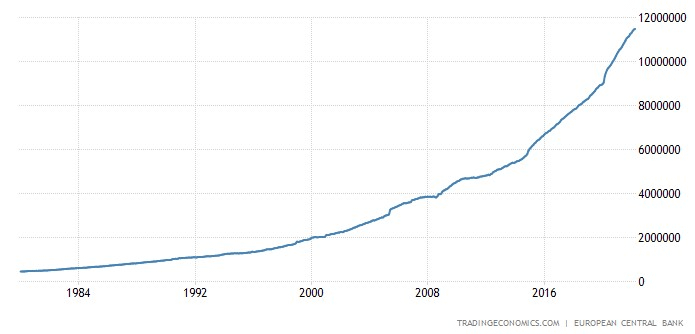
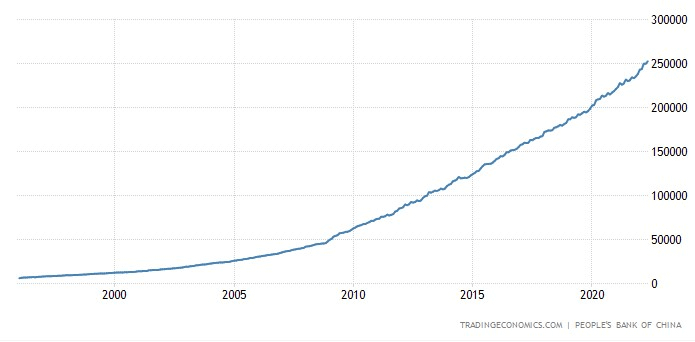
The money supply of competing currencies is not rising as steeply as the dollar’s, but it’s also rising.
The second reason is the second factor in the equation that creates value. Scarcity is not enough to drive value. You also need demand, and if we’re considering the dollar vs. crypto equation, we have to consider the drivers of demand.
Demand for dollars and cryptocurrencies comes from very different sources. Demand for cryptocurrencies is driven almost entirely by the belief that someone else will pay more for them at a later date. Investors call this the Greater Fool Theory. Demand for dollars, on the other hand, is driven almost entirely by use in actual transactions. Because global trade is primarily conducted in dollars, the volume of global trade can serve as a proxy for dollar demand.
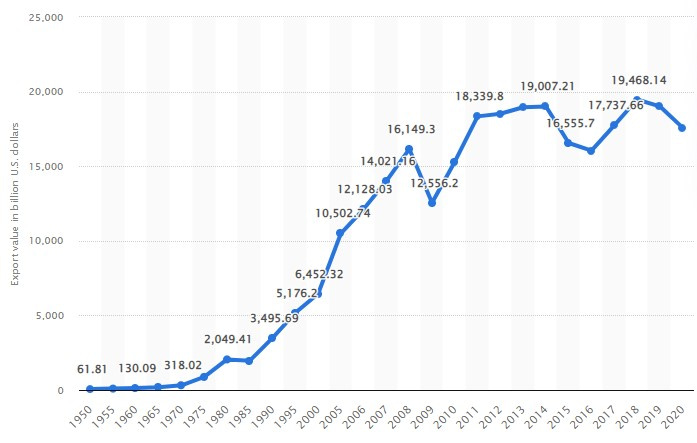
That chart, more than any other factor, explains the resilience of the dollar’s value in the face of ever-increasing supply. As long as demand and supply increase at similar rates, value will remain relatively constant.
If the dollar isn’t dying, how does that affect the dollar vs. crypto equation?
But What About “Petrodollars”?
Since demand for dollars is heavily driven by the use of dollars in global trade, it stands to reason that if trade moved away from the dollar, the value of the dollar would fall. You’ll often hear claims that this is imminent, and the claims usually revolve around “petrodollars,” usually presented as part of a sinister plot to force the world to pay for oil in dollars. This theory holds that if people start paying for oil and gas in currencies other than the dollar, demand for the dollar will evaporate, and the dollar will plunge.
☝ Let’s be clear about one thing. A “petrodollar” is just a dollar spent on oil. That’s it. It’s no different from a dollar spent on anything else. The term gained currency (pun intended) in the 1970s, when Middle East oil producers were accumulating dollars faster than they could spend them, and analysts wondered what they would do with them. There is nothing sinister about the concept.
Another thing that needs to be clear: nobody, anywhere, is required to use dollars to buy oil or anything else. The prices of internationally traded commodities, merchandise, and services are usually quoted in dollars for convenience, but buyers and sellers are free to settle in any mutually agreeable currency. If a refiner in South Korea wants to buy oil from the UAE and pay in Italian Lire or Thai Baht, they can, if the seller agrees.
So Why Does Everyone Use Dollars?
In practice, almost everyone uses dollars, for entirely practical reasons.
- The dollar is liquid. Because of that exploding money supply, there are enough dollars around to underwrite the volume of world trade.
- It’s universally accepted. You can spend dollars anywhere and buy anything with them.
- Dollars are universally convertible at market-determined rates. You can convert the dollar to any other currency at any time, and the government does not generally manipulate exchange rates.
- Banking and settlement systems are effective, established, and trusted. Traders typically prefer to use familiar, trusted systems unless there’s a powerful incentive to change.
Most of all, though, the dollar is used for want of any better alternative. Other countries, notably the EU and China, may increase the use of their own currencies in their own transactions, but they do not want those currencies to emerge as global standards. That would increase demand for those currencies, which would push the value of their currency up, making their exports harder to sell and encourage imports. Trade-surplus entities like China and the EU have a vested interest in keeping the exchange value of their currency low, not high.
What Happens if Traders Use Other Currencies?
Economist C. Fred Bergsten of the Peterson Institute for International Economics has urged the US to “not only accept a more varied currency regime as an inevitable reality but actively encourage such a development as part of its effort to recalibrate its own international economic position”, noting that a lower value for the dollar would promote US exports, reducing the trade deficit and leading to greater employment.
While the world may gradually move toward a multi-currency trade system, the dollar will almost certainly remain the backbone of that system for decades to come. There’s little or no likelihood of an abrupt change.
To go back to the claims about “petrodollars”, what would happen if some oil buyers and sellers used currencies other than dollars? Given that crude oil exports only represent around 6% of world trade and it’s most unlikely that more than a small percentage would move away from the dollar, the answer is “not much”.
Dollar vs Crypto?
The dollar is not going anywhere any time soon… but what does that mean for cryptocurrencies? Are these instruments pitted in an epic dollar vs. crypto battle that only one can win?
This is a comparison between apples and oranges. 78% of the existing supply of Bitcoin, the most popular cryptocurrency, is illiquid, held as a speculative investment. Cryptocurrency has the word “currency” in its name, and you can buy things with it, but almost nobody does, for obvious reasons. Why would you spend something today that you expect to be worth more tomorrow? Bitcoin trades as a static store of value, not as a currency. It’s more analogous to gold than to dollars or any working currency.
The dollar is essentially the opposite. Nobody anywhere buys dollars expecting to sit on them, watch their value grow, and sell them for more than they paid. They buy dollars to use in commercial transactions or dollar-denominated investments. The dollar is not in any sense in a head-to-head competition with bitcoin or any other cryptocurrency. The dollar remains the leading vehicle for global transactions. Bitcoin and other cryptocurrencies are competing with other speculative investment vehicles that do not pay interest or dividends but are expected to increase in value. They are not competing with the dollar.
Constant rapid changes in value are appealing to speculative investors. They are not appealing in a medium of exchange because people engaged in transactions want predictability. Nobody wants to constantly renegotiate the terms of a deal because the value of the medium of exchange is changing on a daily basis. If Bitcoin or another cryptocurrency finds a consistent value it may become useful as currency. If that happens it will also lose its appeal for the speculative investors that dominate the crypto market.
Dollars and Crypto: What’s the Connection?
There is a connection between the proliferation of dollars and the surge in the value of cryptocurrencies. It’s not the connection you might expect, though. Cryptocurrencies are not surging in value because money is flowing from dollar-denominated investments in anticipation of a drop in their value. If that were the case, crypto gains would be matched by equal declines in some other investment class. Instead, virtually every investment class is peaking at the same time.
So what’s happening? Let’s look at one more chart.
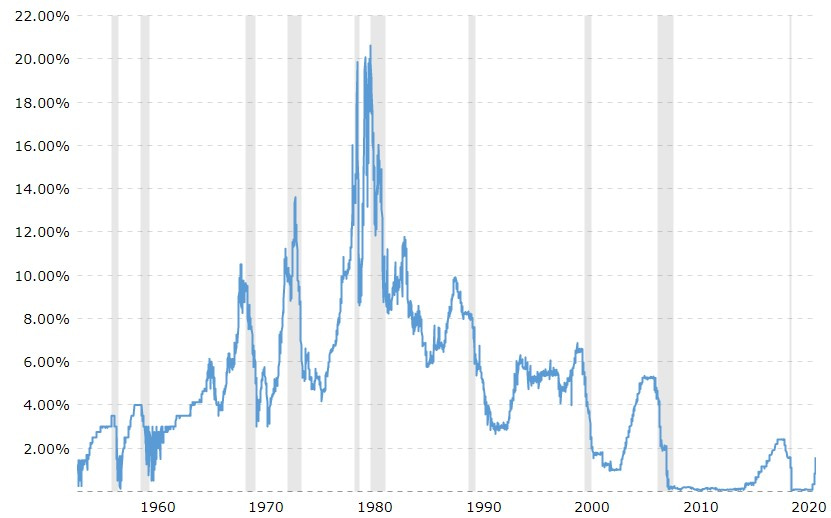
The federal funds rate is the most basic interest rate, the rate all other rates are based on. What we see in that chart is that from 2008 to 2016 interest rates remained close to zero, as the Fed tried to funnel liquidity into the economy to aid recovery from the 2008 recession. From 2016 on the rate crept up but remained at a historic low level of 2.5% or below even as asset markets rampaged to new peaks. In 2020 the rate plunged back to just above zero in response to the COVID-19 pandemic.
When interest rates are very low while asset markets are rising, something predictable happens. That liquidity being pumped into the system doesn’t get invested in new enterprises and it doesn’t trickle down to main street. It goes looking for the largest, fastest returns it can find. That pushes asset markets up. When cheap loans earn high returns we predictably see borrowed money finding its way into asset markets, pumping up the value of investment assets across the board.
📘 The Rise of Meme Stocks: How Viral Trading Hit High Gear in Early 2021
So What Does That Mean?
The surge in the value of popular cryptocurrencies is not happening because investors think the dollar is doomed. It’s not happening because cryptocurrencies are drawing money from other investment classes. It’s simply happening because low interest rates have pushed huge amounts of money into the economy and that money is piling into asset markets across the board. There is no dollar vs. crypto faceoff.
We are in a liquidity-driven bubble. It is not a cryptocurrency bubble: it affects multiple asset classes. What we don’t know is how cryptocurrency values will respond when the bubble bursts, as bubbles always do. Cryptocurrencies could follow gold’s pattern, and gain value as investors back out of what are perceived to be riskier assets. They might plunge to the floor as cash-strapped investors sell for whatever they can get. They may do something in between. We simply don’t know. There is no precedent: cryptocurrencies have never existed in anything but a bull market. We can speculate, but nobody knows.
What we do know is that the response of cryptocurrency investors to market turndown will be defined not by the nature of cryptocurrency but by investor psychology. Understanding cryptocurrency and blockchain is less important than understanding investors and how they make decisions. Technology evolves, often at a vertiginous rate, but decisions to buy or sell are still made by people, and people often don’t evolve as fast as technology. That doesn’t mean you shouldn’t invest in cryptocurrency, as long as it fits your risk profile. It’s still something to consider before making an investment decision.


